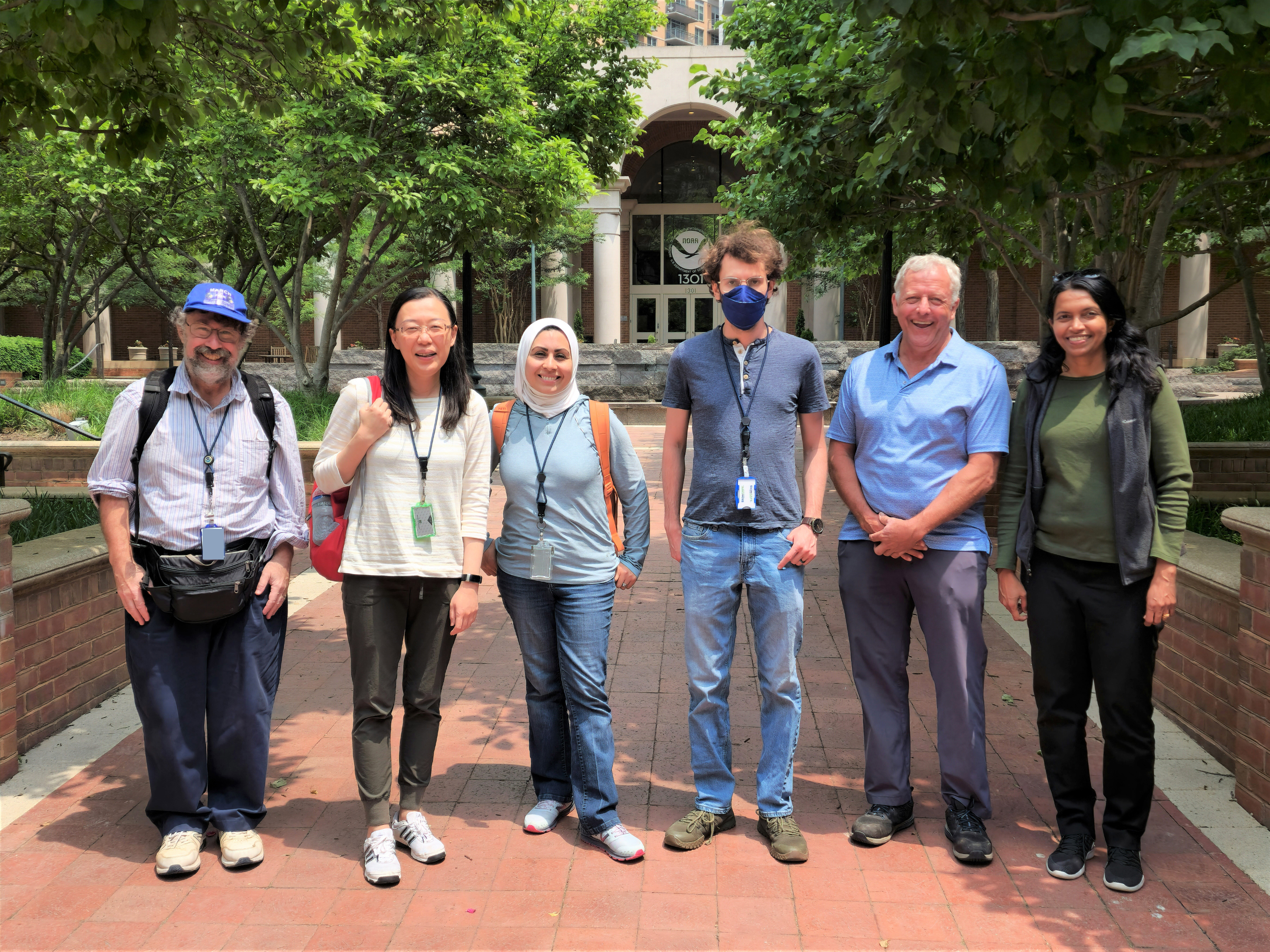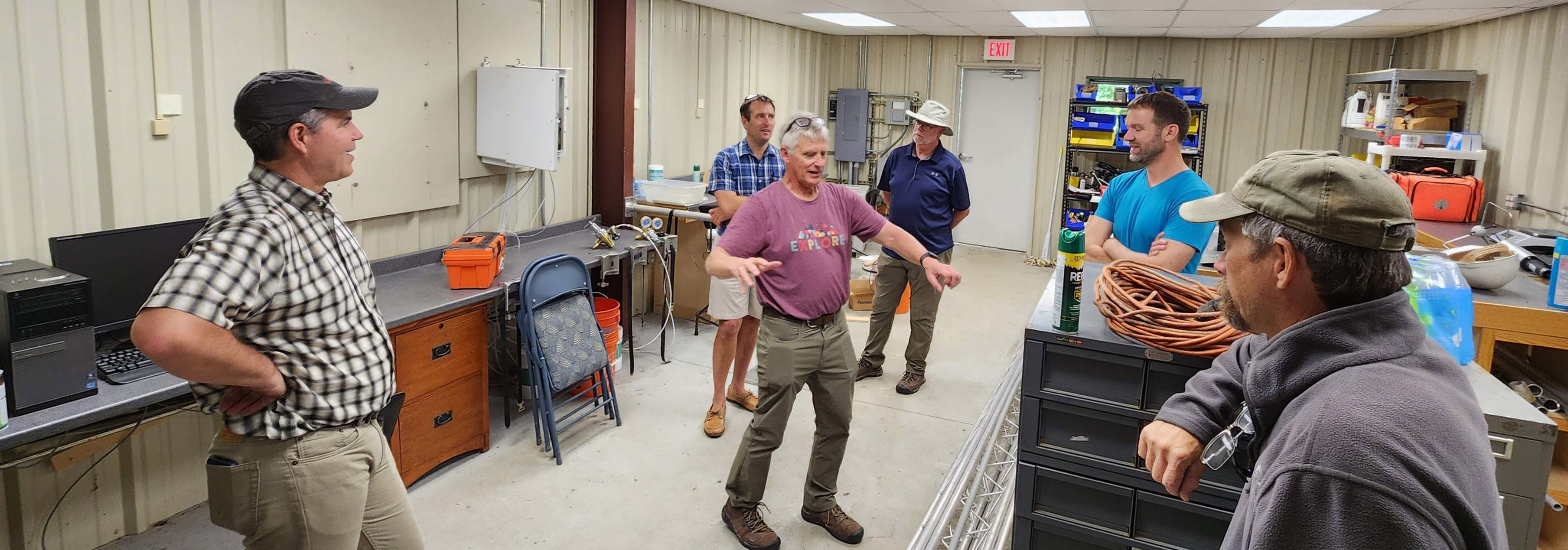ARL Weekly News – May 26, 2023
| Recent Events |
UrbanNet monitoring site visits
On May 23, 2023, Praveena Krishnan, Nebila Lichiheb, Mark Cohen, Fantine Ngan, Randy White and Dominick Christensen visited current UrbanNet monitoring sites at the Herbert C. Hoover (HCHB) Department of Commerce building. They also visited other sites that were part of the old DCnet research network including stations at DC’s Emergency Management Agency (DC EMA 2), the headquarters of the National Education Association (NEA), Howard University, C-SPAN studios and NOAA Silver Spring Metro Center 3 (SSMC-3) building to determine their suitability as future UrbanNet sites. The UrbanNet research program, built on the success of DCnet, is undergoing revitalization to assess the recent changes in urban landscape in the DC metro area by utilizing enhanced meteorological surface observations and greenhouse monitoring over these sites.

From left to right: Mark Cohen, Fantine Ngan, Nebila Lichiheb, Dominick Christensen, Randy White and Praveena Krishnan at the NOAA Silver Spring Campus.
DCNet Site Removal
On Monday, May 22, Randy White, Dominick Christensen, and Winston Luke removed the inactive DCNet site at the Frank D. Reeves Municipal Center in Washington, DC. The building, owned by the District government, will be sold to a private developer who will demolish it and build residential housing on the site. The three removed all the meteorological equipment and data logger from the 50-foot tapered triangular tower, then detached the tower from the building before disassembling and removing it.
On Tuesday, May 23, Randy and Dominick were joined by Drs. Mark Cohen, Praveena Krishnan, Nebila Lichiheb, and Fantine Ngan to tour the remaining DCNet tower installation as well as a future site on Building 3 of NOAA’s Silver Spring campus. All sites were evaluated for their suitability for deployment in the emerging UrbanNet (successor to DCNet) meteorological network in the Washington, DC area.



Dave Turner visits ATDD.
Dave Turner from NOAA’s Global Systems Laboratory (GSL) visited ARL/ATDD May 22 – 24. Tilden Meyers also visited during this time. Dave met with many ARL engineers and scientists to learn more about our expertise and discuss future and ongoing collaborations on boundary layer research and emerging technologies. Dave is working to create research projects that bring different disciplines (like modeling and observations) and various NOAA/OAR laboratories together.

Chestnut Ridge, with Dave Turner, Temple Lee, Tilden Meyers, Rick Saylor, Mark Heuer, and Ed Dumas (from left to right).
EPA CASTNET Science Advisory Board Review
Winston Luke attended and submitted public comments at the meeting of the EPA’s Science Advisory Board (SAB) reviewing the operation and future network design of the agency’s Clean Air Status and Trends Network (CASTNET).
“CASTNET is a long-term atmospheric monitoring program with 99 sites located throughout the United States and Canada, …and is managed and operated by the U.S. Environmental Protection Agency (EPA) Office of Atmospheric Protection in cooperation with the National Park Service (NPS) Air Resources Division; Bureau of Land Management, Wyoming State Office (BLM); and other federal, state, and local partners including seven Native American tribes. The network was established in response to the 1990 Clean Air Act Amendments to assess the effectiveness of emission reduction programs by reporting trends in pollutant concentrations and acidic deposition. Data from CASTNET also support the assessment of the primary and secondary National Ambient Air Quality Standards (NAAQS) for ozone (O3), nitrogen dioxide (NO2), sulfur dioxide (SO2), and fine particulate matter (PM2.5). Additionally, CASTNET data are used for assessing air pollution impacts to sensitive ecosystems and applications related to environmental assessments and permitting.
CASTNET sites measure weekly ambient concentrations of sulfur and nitrogen species (filter pack) as well as hourly O3 concentrations. Long-term measurements from CASTNET are an important tool for assessing trends in air quality in response to regulatory actions (e.g., Acid Rain Program, Cross-State Air Pollution Rule) and climate change.” (https://www3.epa.gov/castnet/docs/CASTNET-Factsheet-2021.pdf)
EPA requested the SAB review to assess CASTNET’s overall performance and guide future network design and operations in the face of budgetary pressures. Dr. Luke delivered a public comment of support, crafted from discussions with Drs. Mark Cohen, Howard Diamond, and LaToya Myles. These comments supplemented a letter of support drafted by Dr. Ariel Stein and delivered to the SAB prior to the May 24-26 meeting.
WMO on Greenhouse Gas monitoring
During the week of May 22, 2023, the 19th Congress of the World Meteorological Organization (WMO) approved a formal resolution on Greenhouse Gas monitoring. The resolution involved the adoption of a new Global Greenhouse Gas Watch (G3W) that was recognized by the WMO Congress delegates, The director of ARL, Dr. Ariel Stein played a key role in the WMO Study Group on Greenhouse Gases (SG-GHG) and this Study Group was tasked with developing an implementation plan for the G3W, and the SG-GHG will now work to revise the Terms of Reference for the new G3W to ensure that all the necessary expertise is on board and capable of delivering what is being requested by the WMO Congress. ARL’s Dr. Christopher Loughner was also involved in this when he attended and made a presentation at the Greenhouse Gas Monitoring Symposium that was held in Geneva, Switzerland from January 30 to February 1, 2023, and it was attended by more than 170 stakeholders from academia and public and private sectors. The outcome of that Symposium was the issuance of a call for the WMO to take the lead in coordinating an international effort to establish top-down coordinated greenhouse gas monitoring in support of the implementation of the Paris Agreement.
Currently, monitoring of the implementation of the Paris Agreement is entirely based on bottom-up estimation of anthropogenic greenhouse gas emissions, using methodologies established by the Intergovernmental Panel on Climate Change (IPCC). These estimates are generally considered to be of good quality in industrialized countries. However, in many developing countries, the underlying economic data required for bottom-up estimation are unavailable, and the methodology thus cannot be applied. In addition, natural sources and sinks of greenhouse gases, many of which are associated with even larger fluxes, cannot readily be monitored using bottom-up estimation. This leads to continued uncertainty about some of the processes behind the continued rise in atmospheric concentration of greenhouse gases, about the effectiveness of various kinds of mitigation action, and about how natural sources and sinks of greenhouse gases may respond to the ongoing climate change. However, top-down greenhouse gas monitoring provides supplementary methodology for estimating when and where greenhouse gases enter and exit the atmosphere, based on the direct use of observations of atmospheric greenhouse gas concentrations in conjunction with atmospheric modelling and data assimilation. The models, data assimilation, observing network and data exchange that is required for top-down monitoring of greenhouse gases all have much in common with their parallels in the World Weather Watch, which has been successfully operated by the WMO Members for 60 years. Top-down monitoring is now becoming a mature methodology and it is being implemented operationally by one group of WMO Members, with pre-operational activities being undertaken by at least three other Members. However, the surface-based parts of the greenhouse observing system are still relatively weak, and there is no consolidated design of an integrated observing network across Earth System domains and platforms that would fully meet the requirements. Moreover, there is currently no coordination framework through which the ongoing operational and pre-operational activities would be able to leverage one another for improved product quality and increased ability to provide transparent, high quality and authoritative data on greenhouse gas fluxes to the Parties of the Paris Agreement.
The establishment of a standing Watch will elevate the importance of such GHG monitoring and modeling that takes place not only at ARL, but at other NOAA OAR Labs such as the Global Monitoring Laboratory, and serves as a great backdrop for the NOAA GHG Workshop to take place from June 5-6, 2023, in Silver Spring, MD, where the NOAA GHG community will engage in a set of wide ranging agency discussions of GHG research, data, products, information and plans.
Acquisition Conference
Barbara Shifflett and Gabrielle Land will be attending the Delegated Procurement Authority (DPA) Field Delegate training in San Diego, CA May 31 through June 1, 2023.
| Publications |
Accepted: Surf, turf, and above the Earth: Unmet needs for coastal air quality science in the planetary boundary layer (PBL), accepted to Earth’s Future.
Sullivan, J.T., R.M. Stauffer, A.M. Thompson, M.A. Tzortziou, C.P. Loughner, C.E. Jordan, and J.A. Santanello (2023). Surf, turf, and above the Earth: Unmet needs for coastal air quality science in the planetary boundary layer (PBL), accepted to Earth’s Future.
Abstract: Coastal areas are some of the most densely populated and economically important regions in the world. As such, protecting the health of the human population and ecosystems at the coastal interface and understanding the impacts of environmental stressors such as air pollutants provides wide-ranging benefits. Air quality processes within coastal regions have been studied using ground and space-based platforms, with intensive field campaigns focused on addressing key science questions that are typically partitioned into either direct atmospheric effects (e.g., anthropogenic emissions creating air pollution) or indirect processes and feedback loops (e.g., terrestrial/marine biogenic processes modifying atmospheric properties). The atmospheric planetary boundary layer (PBL) and its depth or height (PBLH) connect land, air, and the water surface via many pathways, especially with transport and exchange processes tied to the complexities of the coastal interface. We still cannot accurately characterize – through field, aircraft, or space-based observations – the spatial and temporal PBL variability and processes within the PBL that couple together coastal dynamics and air quality. Several upcoming geostationary and polar-orbiting satellite missions are likely to make significant progress in characterizing these air/land/water interactions over the next decade. Here, we present a framework of the current understanding of the PBL’s role in coastal regions, primarily regarding air quality and atmospheric deposition, to motivate future concerted efforts from ground- and space-based platforms to achieve a holistic understanding of the coastal interface.

